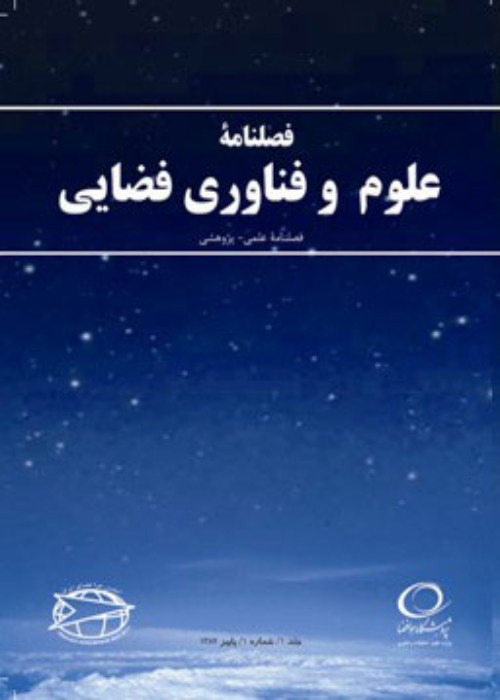فهرست مطالب
نشریه علوم و فناوری فضایی
سال شانزدهم شماره 3 (پیاپی 58، Autumn 2023)
- ویژه نامه انگلیسی
- تاریخ انتشار: 1402/08/17
- تعداد عناوین: 5
-
-
Pages 1-23Many studies have investigated the problem of external disturbance rejection and also increasing the attitude control system's robustness against the parametric uncertainties. Due to stochastic properties, noise effect minimization becomes an interesting and challenging problem in the field of spacecraft attitude control that has been underestimated, while control actuators and attitude sensors themselves are important sources of noise generation., the main purpose of this paper is to (i)control the satellite’s attitude and (ii)minimize the variance of output, simultaneously. The Minimum Variance controller, which is considered the simplest type of model predictive controller, has a powerful capability for minimizing the effects of output noise. This feature makes it a suitable control scheme for space-based high-resolution photography missions. so,, we described the conventional Minimum Variance regulator method at first, then an Incremental version of the regulator has been presented to solve the tracking problem. Finally, the generalized minimum variance controller which can control both minimum-phase and non-minimum-phase systems is derived for a high pointing accuracy spacecraft. The simulation results show the efficiency of the proposed controller to restrain the noise effects in a high-resolution tri-stereo imaging mission.Keywords: Attitude control, Minimum variance, Very-High-Resolution Imaging, Stereo imaging, Parasitic noise
-
Pages 25-38This paper presents a new control methodology based on Continuous Time Delay Petri Nets (CTDPN) tool for the attitude control of satellite simulator. The graphical and mathematical features of this tool help the expert designer to design an appropriate controller using graphical model easily, and then apply the necessary changes to the mathematical model. In this approach, the controller gains are derived from the states and some other variables. Thus, the system states and variables must be available. The new gain tuning algorithm consists of three stages. First, A simulation environment is made for mathematical modeling based on the CTDPN tool and controller design. Secondly, using optimal methods, the controller gains are calculated at any given time and the data are collected. Finally, using the database, a relationship between the set of variables and the gains are derived. Experimental results indicate the promising performance of the controller in comparison to the conventional controller applied to the satellite simulator platform. The results indicate that the designed controller is robust against variation of parameters, as the controller gains are tuned based on the system state and variables.Keywords: Attitude control, CTDPN, Stability Analysis, Gains tuning, Satellite simulator &lrm, platform
-
Pages 39-50The Monopropellant Hydrazine Propulsion system is one of the most widely used types of single-agent propulsion systems to control the position or correction of satellites in orbits. This system consists of combustion chamber subsystems (catalyst bed, catalyst, nozzle, and cap), fuel and fuel tank, high-pressure tank, control valves, and interface pipes. In this paper, the MPHP system (as a case study) is described in detail, and then critical risks are identified by creating FMECA tables on the case study in the design phase. Based on the proposed FMCEA flowchart, potential failure modes are identified. In the next step, decisions and corrective actions are formulated regarding the inherent failures of the system. Finally, the necessary measures to reduce the risks will be taken according to the system's failure modes, and the reduction of the identified risks to an acceptable level is presented. The attained results show that the catalyst decomposition chamber, catalyst bed, inlet flow control valve, and propellant management facilities units have the highest risk index values (RPN), respectively. For this purpose, corrective measures have been suggested for each of these.Keywords: Monopropellant Hydrazine, Risk Assessment, FMECA, Expert Opinion, Failure modes
-
Pages 51-64Linear algorithms are the most widely used method for satellite attitude control using reaction wheels because of their simplicity and low computational cost. The first part of the paper introduces different attitude determination and control algorithms, and reviews resources that utilized optimal linear and nonlinear control methods (such as LQR and SDRE). Next, dynamic equations for the control of the satellite using reaction wheels have been extracted, then the satellite controller has been designed by using optimal linear and nonlinear methods, which are robust against noise and disturbance, as an alternative for the PD controller. Finally, the designed control algorithms have been implemented for different satellite pointing scenarios, and by simulating these methods in MATLAB software, their performance has been studied and compared.Keywords: Nanosatellite, satellite control algorithms, Reaction wheel, Optimal control, LQR, SDRE
-
Pages 65-71The extreme temperature fluctuations and the vacuum of the space environment make growing plants in outer space challenging. To simulate the temperature fluctuations and vacuum conditions associated with space environments, dry tomato seeds were placed in a thermal cycle simulator and vacuum simulator chamber of space systems, respectively. A Bradford method was used to determine the total protein content of each group of seeds. Sodium dodecyl-sulfate polyacrylamide gel electrophoresis was used to separate proteins. The seed of the thermal cycle group had the highest protein content (26 to 31 mg/ml), followed by control seeds (8-10 mg/ml) and the vacuum seeds (4-5.6 mg/ml). The molecular weights of the peptides ranged from 8 to 42 kDa. The intensity of the protein bands was significantly different in the thermal cycle group from the other two groups, and vacuum group had the lowest intensity. Water and oil released from seeds in the vacuum environment resulted in a reduction of protein content. In the thermal cycle group, the total protein content and the intensity of the bands were significantly higher than those treated with the control group, which can be attributed to the degradation of storage proteins involved in seed germination in the control group.Keywords: SDS-PAGE, Solanum lycopersicum, Space, Spacecraft, Thermal cycle, vacuum


